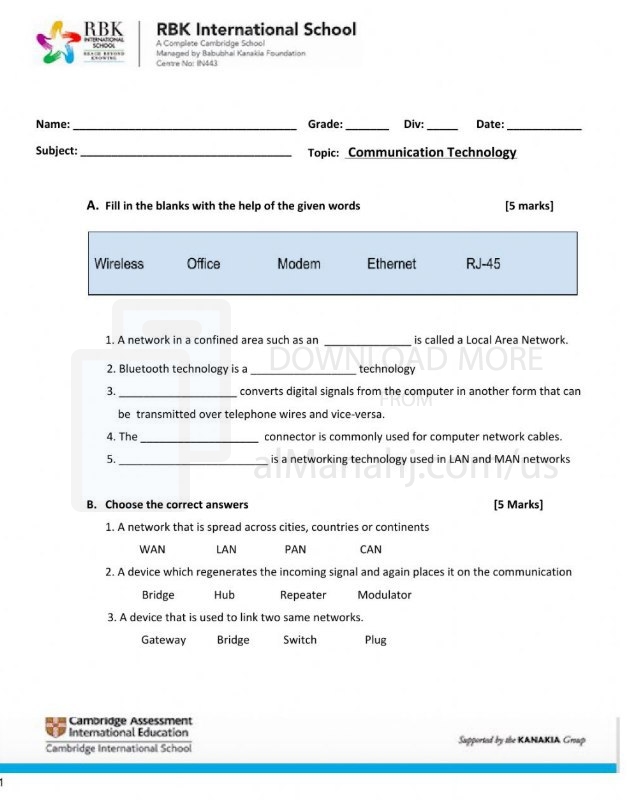| You are here: Almanahj Website ⇒ American curriculum ⇒ 6th Grade ⇒ Information and comm ⇒ Term 1 | ||
|---|---|---|
Worksheet about Different types of network | ||
|---|---|---|
| Subject: Information and comm | ||
| 6th Grade | ||
| Term 1 | ||
| Year: 2023/2024 | ||
| Size: 259.7KB | ||
| Number of clicks: 109 | ||
| Publish date:November 12, 2023 | ||
| Added by: Eman | ||
| Last download date: 2024-09-12 15:37:22 | ||
| Updated by: Eman9966 on 2023-11-12 16:16:01 | By: theodor Sreeja_Nair | |
| File info: Different types of networks There are many different types of networks, each with its own unique purpose and characteristics. Here are some of the most common types of networks: Personal area networks (PANs) connect devices within a close proximity, such as within a single room or home. PANs are often used to connect personal devices such as smartphones, tablets, and laptops. Local area networks (LANs) connect devices within a small geographic area, such as a single building or campus. LANs are often used to connect computers, printers, and other devices in a business or school. Metropolitan area networks (MANs) connect devices within a large geographic area, such as a city or metropolitan area. MANs are often used to connect LANs together or to connect to the internet. Wide area networks (WANs) connect devices over long distances, such as across countries or continents. WANs are often used to connect businesses, governments, and other organizations together. Internet is the largest WAN in the world. It connects billions of devices around the globe. The internet is used for a variety of purposes, including communication, entertainment, and commerce. Intranet is a private network that is accessible only to authorized users. Intranets are often used by businesses to share information and resources with employees. Extranet is a network that is accessible to both authorized users and the public. Extranets are often used by businesses to share information with customers or partners. Network topologies Networks can also be categorized by their topology, which is the physical layout of the network. Common network topologies include: Star topology has a central hub or switch that connects all of the devices on the network. Bus topology has a single cable that connects all of the devices on the network. Ring topology has a closed loop of cable that connects all of the devices on the network. Mesh topology has every device connected to every other device on the network. Tree topology is a combination of star and bus topologies. Network protocols Networks use protocols to communicate with each other. Protocols are sets of rules that define how data is exchanged between devices on a network. Common network protocols include: Transmission Control Protocol/Internet Protocol (TCP/IP) is the most common protocol used on the internet. Ethernet is a protocol used for local area networks. WiFi is a protocol used for wireless local area networks. Bluetooth is a protocol used for short-range wireless devices. The type of network that is best for a particular application depends on a number of factors, including the size of the network, the geographic area that the network covers, and the types of devices that will be connected to the network. | ||
| Downloading link Worksheet about Different types of network |
|---|
|
1699787071.pdf
The file is being prepared for download
|
| File images |
|---|
 |